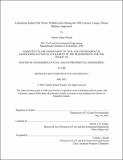Estimating Sudan Nile Water Withdrawals During the 20th Century Using a Water Balance Approach
Author(s)
Woods, Natalie Elaina
DownloadThesis PDF (6.826Mb)
Advisor
Eltahir, Elfatih A.B.
Terms of use
Metadata
Show full item recordAbstract
The Nile Basin boundaries define the catchment area for the longest river in the world, which is shared by 11 sovereign states, each with a varying amount of power in basin water negotiations. For several countries in the region experiencing rapid population growth, claiming a portion of shared surface water resources will be key to reducing poverty, increasing agricultural production, improving resilience to climate variability, and powering industrial growth. Egypt and Sudan currently claim the largest share of Nile waters, but exact estimates of withdrawals by Sudan over several years are difficult to find. The goal of this thesis is to estimate Nile water withdrawals by Sudan from the 20th century until the present using water balance concepts.
The analysis of Sudan’s water balance relies on estimates of evaporation from the Nile River and constructed reservoirs, and on estimates of water consumed for agricultural production. This study derives estimates for both, using gridded climate data and reported national blue water evapotranspiration of agricultural commodities. Evaporative losses from the Nile River and major reservoirs within Sudan are estimated at 4.62±0.92 km³ annually, with a substantial contribution of 2.04±0.41 km³ yr ⁻¹ evaporated from Jebel Aulia and Roseires Reservoirs. Surface water withdrawals for primary crop and livestock production average 13.83±0.69 km³ yr ⁻¹ over the most recent decade of available data. National agricultural production follows the same trend as total Nile water withdrawals due to the agricultural sector dominating Sudan’s economy. Uncertainty around the water footprint of the entire agricultural sector and other non-evaporative losses such as aquifer recharge remains significant. For example, we estimate that about 2 km³ yr ⁻¹ (anywhere between 1 and 4 km³ yr ⁻¹) may be lost to groundwater storage, specifically the Nubian sandstone aquifer. It was found that, as of 2005, Sudan’s total water withdrawals, estimated to be within the range of 13.5 to 17.5 km³ yr ⁻¹ are close to the threshold of consuming its entire share of Nile waters according to its agreement with Egypt. This result, along with planned and underway construction of hydroelectric dams and irrigation schemes elsewhere in the basin, emphasizes the need for reasonable and equitable water sharing and transparent, cooperative water resource management among Nile River riparian countries in the coming decades.
Date issued
2021-06Department
Massachusetts Institute of Technology. Department of Civil and Environmental EngineeringPublisher
Massachusetts Institute of Technology